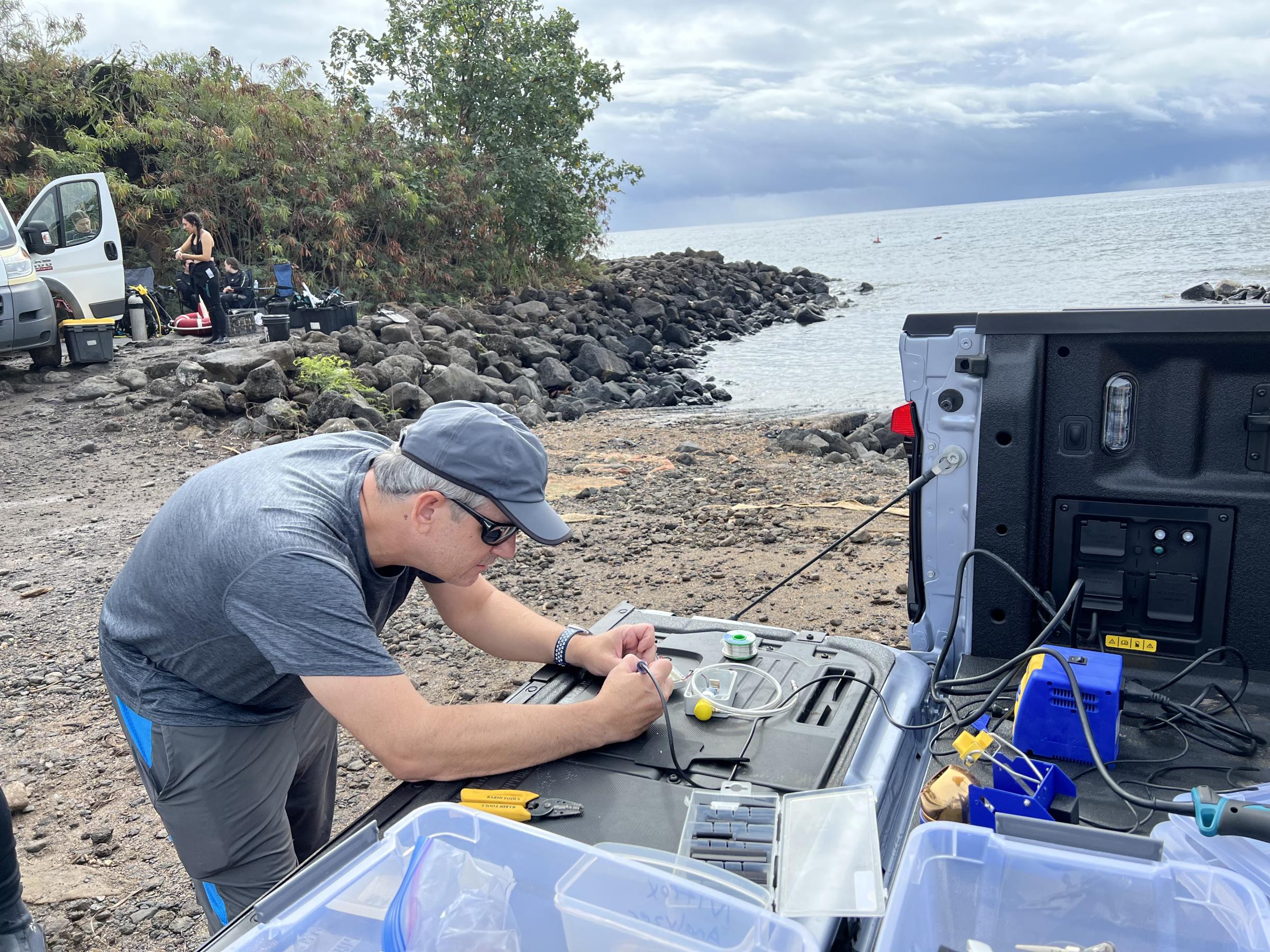Cynthia and Chris Luff with their Ford Lightning truck
JOY RIDE: Ford F-150 Lightning All-Electric Truck
By Allison Young
Calling all truck lovers! The Ford F-150 Lightning is Ford’s first all-electric truck. Unveiled in May 2021, Ford began production in April 2022. The base model price was originally listed at $39,974, making it more accessible than other EV trucks on the market.
Wainiha residents Chris and Cynthia Luff visited KIUC on January 25 and used the Level II charger in the parking lot. We talked story about how they became Lightning owners and electric vehicle enthusiasts.
When did you start driving the Lightning?
Chris: I got on the waiting list in the middle of the online web reveal in May 2021. I started driving in October 2022. Ford first produced 25,000, but by now the demand far outstrips supply—the waiting list has over 300,000 people. I give Ford a lot of credit for shipping out to regular people and not just family and friends.
What was your original motivation for switching to an EV?
Cynthia: There were so many cool things about it. Ask any EV owner, once you have an EV, it’s hard to go back. One self-reported survey said that over 90% of EV drivers don’t go back to driving gas-powered vehicles. For us, it’s more about convenience than anything. The closest gas station is in Princeville.
Chris: This is my third EV. First we had a 2016 Tesla Model S, then a 2018 Zero DSR motorcycle.
What do you think truck drivers would appreciate about the Lightning?
Chris: It’s an island-friendly vehicle. It has all-wheel drive, so when the rain comes you can get through muddy situations. Ford also designed the Lightning to have the same cab as its other F-models, which means that it feels like a regular truck, and many parts are the same as the F-150 for maintenance.
What’s your favorite feature? Any cons?
Chris: I like that we could potentially use the Lightning battery as a backup generator, although I’m still working through getting that functionality set up with my house. With its bidirectional outlet (the charge can go both ways), it can theoretically support the house for 10 days. So far, I have only used the bidirectional outlet once when scuba diving. I needed a tool to solder equipment, and was able to plug it in while at the beach.
Other features I like: Driver assist controls the speed and stays in the lane on the highway. With regenerative one-pedal braking, I barely touch the brake anymore. And I really like the 360-degree camera with bird’s eye view.
My only con is that the car's software only updates through a cell network, not Wi-Fi, which is an issue in Wainiha.
Cynthia: I’m always cold, so I like the seat warmers. And when you back up, it plays Mario Kart music!
Have you received much attention since getting it?
Chris: You should see the stares when we open the “frunk” up in a parking lot. Other truck drivers approach us with curiosity. A lot of people recognize it, and the attention has been positive.
Because there is no engine in the front, a “front trunk” or “frunk” was designed for additional storage. Both the frunk and the bed have standard home outlets (2.4 kilowatts and 7.2 kW, respectively).
What is something that would make people who are skeptical about EVs want to try this one?
Chris: Range anxiety is a complete nonissue. On a full charge, I can drive 350 to 400 miles and still fully charge overnight. The extra range means that you could put on a lift kit and oversized tires and still have plenty of range.
In terms of speed, it’s way more speed than we need on Kauai. It goes to 50 mph in 3 seconds. It is a stable ride because the weight is distributed low underneath.
Like most EVs, the battery weight makes the Lightning significantly heavier—2,000 to 3,000 pounds more than the same model’s combustion version—which drivers and pedestrians need to keep in mind for safety.
How do you charge it?
Chris: I have only charged it at home (using a NEMA 14-50 Level II charger). We installed PV solar at our house with 2 batteries (Tesla Powerwalls). With the range, it hasn’t been needed to charge elsewhere, and I prefer to keep the public chargers free for people that need them.
How much do you think you save on gas per month?
Chris: It’s complicated to calculate. I appreciate that KIUC rates were more stable during the pandemic. Charging from the grid, I may save about half the cost of gas. Our preferred method is to charge from solar, and that reduces our cost to $0.
Mahalo, Chris and Cynthia. To learn more about EVs, KIUC’s Level II Multi-port Charger Rebate Program and other resources, visit kiuc.coop/ev. Chris and Cynthia sometimes participate in KauaiEV events, which you can find at kauaiev.org.




